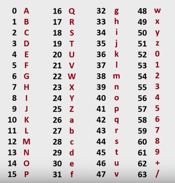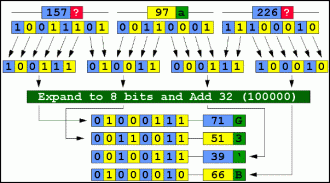

As the name suggests, there will be 64 characters in Base64 string. Base64 encoding and decoding is a popular method to encrypt and decrypt the data. The encoding and decoding are important in order to prevent the data from malware attacks. In Base64 encoding, 3 binary bytes are represented as 4 characters. I’m going to implement PEM/MINE but I’m not going to implement new line support.

PEM and MIME may use the same characters but they have different maximum line lengths. To know the length of the original data, we must understand how Base64 works. A base64 string looks like this: Length of data. Putting binary data inside an xml file, for example, could act weird, but a Base64 string acts just like normal text. The goal is to make it easier to transfer. The general rule is to choose a set of 64 characters that is both 1) part of a subset common to most encodings, and 2) also printable. Base64 is a way to encode binary data in ascii data. Design The particular choice of characters to make up the 64 characters required for Base64 varies between implementations. Explanation taken from here Sample Decode PEM and MIME encoding are the most common and use +/ as the last two characters. The Base64 term originates from a specific MIME-content transfer encoding. '=' characters might be added to make the final block contain sixteen base64 characters. Groups of 6 bits (6 bits have a maximum of 26 = 64 different binary values) are converted into individual numbers from left to right (in this case, there are fifteen numbers in a 88-bit string), which are then converted into their corresponding Base64 character values (see above table).Īll 88 bits will be captured in the first fifteen base64 digits (90 bits). UnsupportedEncodingException import java. The decoder ignores all line separators and other characters not found in the basic base64 alphabet. Each line (except the last line) is separated from the next line via a carriage return (\r) followed by a linefeed (\n). The encoded output is organized into lines of no more than 76 characters. MIME enforces a limit on line length of Base64 encoded data. This transmission can be considered as composed by 8 bit characters so it is base256: each byte is a symbol from 0 to 255. MIME: The MIME variant uses the Basic Base64 alphabet ( A-Za-z0-9+/). Answer (1 of 6): The idea behind Base64 is very simple. The decoder rejects data that contains characters outside A-Za-z0-9-_. URL and Filename Safe: It is same as the Basic Base64 encoding except that + is replaced by - and / is replaced by _ to make the output URL and filename safe. The decoder rejects data that contains characters outside this set. The algorithm converts the input to a set of characters containing A-Z, a-z, 0-9, + and /. Basic: This is the standard Base64 encoding defined in the RFC 4648.Java 8’s Base64 API contains implementations for all the Base64 encoding and decoding variants described in the official RFC 4648.įollowing variants of Base64 encoding and decoding is supported. The 'standard' alphabet uses A-Z, a-z, 0-9 and + and /, with as a padding character. Essentially each 6 bits of the input is encoded in a 64-character alphabet.
Base64 encoding with 64 length basic plus#
It takes 4 characters per 3 bytes of data, plus potentially a bit of padding at the end.

Base64 encoding with 64 length basic how to#
In this article, you’ll learn how to Base64 decode any Base64 encoded text back to binary data. It's basically a way of encoding arbitrary binary data in ASCII text.


 0 kommentar(er)
0 kommentar(er)
